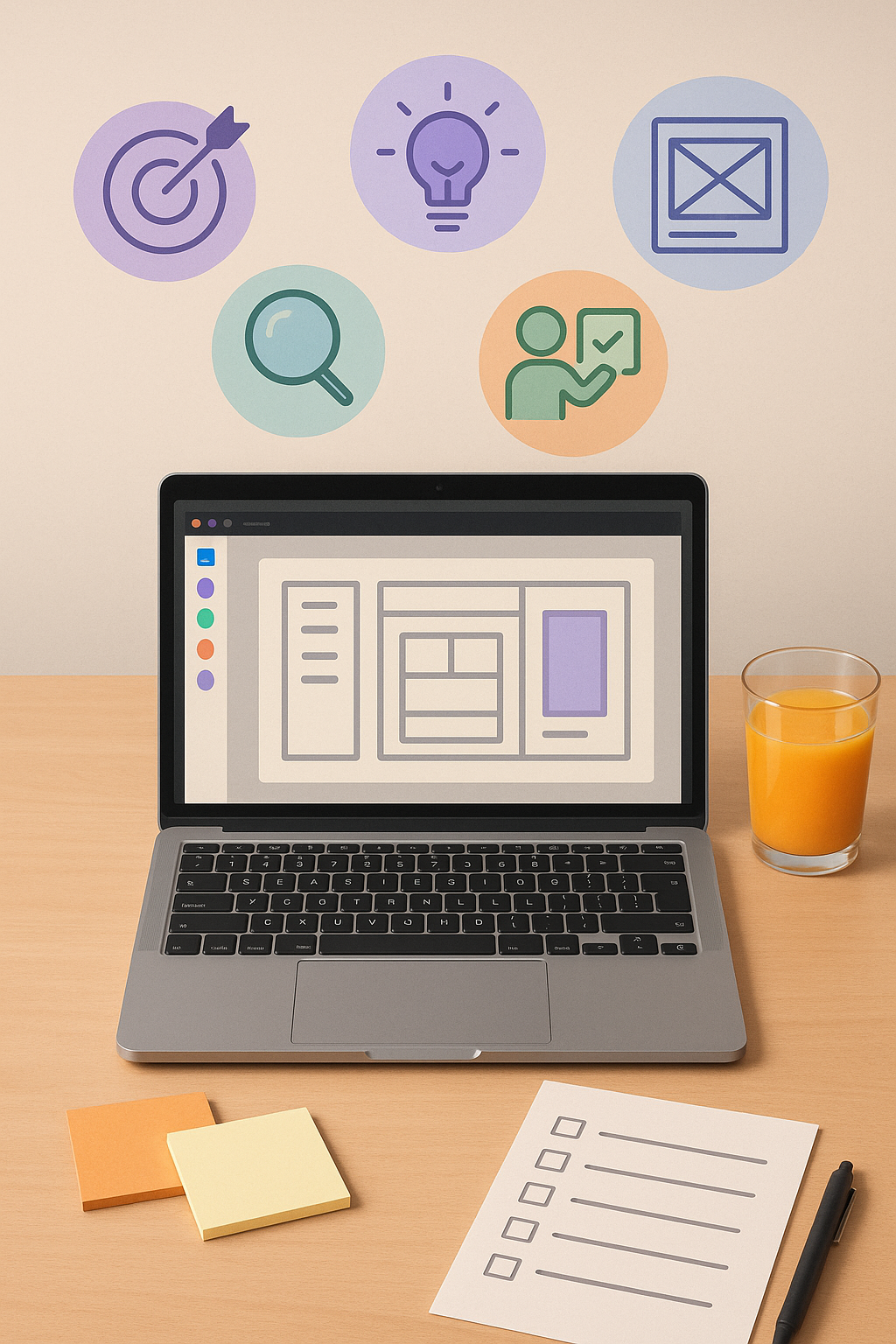How to Kick Off a Design Project (Even If You’re Just Starting)
Starting a design project can feel overwhelming, especially if you’re unsure where to begin. Whether you’re a seasoned designer or just getting started, a structured approach makes everything smoother, faster, and way less stressful.
I remember my early days juggling design work without a clear roadmap — just diving in, letting creativity lead. Sometimes it worked. Most times, not so much. Over time, I’ve learned that great design starts with a solid foundation. Let me walk you through how I now kick off projects — from first idea to final handoff. And if you’re a client reading this? Don’t worry — it’s normal to feel unsure in the beginning too. We’re in this together.
DEFINE THE PROJECT GOALS
Start with the “why.” Before touching any tool, get clear on the purpose.
Ask yourself:
- What is the design for?
- Who’s it for?
- What do I want it to achieve?
Clear goals make decisions easier. When I redesigned a nonprofit website, just knowing the main goal was “increase volunteer signups” guided every choice we made.
DO YOUR RESEARCH
No design exists in a vacuum. Research gives your project context and direction.
Focus on:
- Audience: Who are they? What do they care about?
- Trends: What’s gaining attention in your field?
- Competitors: What are others doing well (or badly)?
I once skipped this step for a quick app mockup. The design looked slick, but users were totally lost. I’ve never skipped research since.
WRITE A SIMPLE BRIEF
A short brief keeps everyone aligned.
Include:
- Overview and goals
- Target audience
- Deliverables
- Tone or style direction
- Key dates and responsibilities
Even a one-page document helps a lot. I keep mine in Notion or Google Docs to stay organized and collaborative.
BUILD THE RIGHT TEAM
If you’re working with others, clarify roles early.
You may need:
- UX designer
- UI designer
- Developer
- Copywriter
- Project manager (could be you!)
When everyone knows their part, projects run way more smoothly.
MAKE A REALISTIC TIMELINE
Break the work into phases. For example:
- Discovery
- Sketching
- Design
- Prototyping
- Testing
- Final delivery
Use tools like Trello, Notion, or Asana to set deadlines and track progress. Always add buffer time — because delays happen.
BRAINSTORM SMARTLY
This is the fun part — but do it after research and planning.
Try:
- Mind maps to explore ideas
- Mood boards for visual tone
- Quick sketches to experiment
For a branding project, we tried five very different directions before landing on the right one. Exploration is key.
SKETCH AND WIREFRAME
Sketching is fast idea generation. Wireframes give your design shape.
Tools:
- Sketching: Paper, iPad, or whiteboard
- Wireframes: Figma, Balsamiq, or even Keynote
This phase helps clients and teammates see the layout before you dive into visual polish.
BUILD A PROTOTYPE
Once wireframes are approved, build an interactive version.
Use tools like Figma or Adobe XD to:
- Create clickable elements
- Simulate flows
- Preview real interactions
This gives a feel for the design before anything’s coded.
TEST WITH USERS
Don’t wait until launch to gather feedback.
What to do:
- Share the prototype with a few real users
- Ask them to complete tasks (like “find the contact page”)
- Observe where they get stuck and adjust
I once assumed a layout was intuitive — until testers missed the main CTA completely. User testing saved the project.
FINALIZE AND DELIVER
After approval:
- Name files clearly
- Export assets in needed formats
- Double-check consistency
- Add notes for developers if needed
A clean handoff shows professionalism — and respect for everyone’s time.
AVOID THESE MISTAKES
Some lessons I learned the hard way:
- Starting without clear goals
- Skipping the brief
- Assuming I knew what users needed
- Getting too attached to early ideas (Been there — like the time I fell in love with a homepage layout that everyone else found confusing. Letting go hurt, but the final result worked way better.)
Design is a process. Stay open and flexible.
HANDY TOOLS
These have saved me time and sanity:
- Figma – design + prototype
- Notion – briefs + timelines
- Miro – brainstorming
- Loom – quick walkthroughs
- Trello / Asana – project tracking
- Google Forms – user feedback
Pro tip: Download a free design brief template and tweak it to your needs.
PROJECT SNAPSHOT: REDESIGNING A WEBSITE
Example:
- Goal: Make a local business site modern + increase contact form submissions
- Audience: Adults 35–55, desktop users
- Research: Competitor review showed clean CTAs worked best
- Brief: Noted that current site lacked visual hierarchy
- Timeline: 6 weeks, with check-ins
- Sketches: Explored three layout directions
- Prototype: Built in Figma, tested with users (Five users tested the prototype in short, moderated sessions — each was asked to find and fill out the contact form.)
- Results: Feedback led to redesigning the contact form — now easier to use
- Handoff: Delivered assets and notes to developers smoothly
STARTER CHECKLIST
Before starting any new design, ask:
- ✅ Do I know the main goal?
- ✅ Who is the audience?
- ✅ Do I have a brief?
- ✅ Have I done my research?
- ✅ Is everyone’s role clear?
- ✅ Do I have a realistic timeline?
- ✅ Have I brainstormed/sketched?
- ✅ Have I built wireframes or a prototype?
- ✅ Have I tested with real users?
- ✅ Are all files neat and ready to hand off?
FINAL THOUGHTS
Great design doesn’t happen by accident. It starts with intention. Be curious. Ask questions. Start smart, and you’ll finish strong.
Since I’ve adopted a more structured start, projects feel more creative and collaborative — and way more fun. Walk in prepared, and you’ll walk out proud.
From zero to design hero — keep creating!
by Cris.

